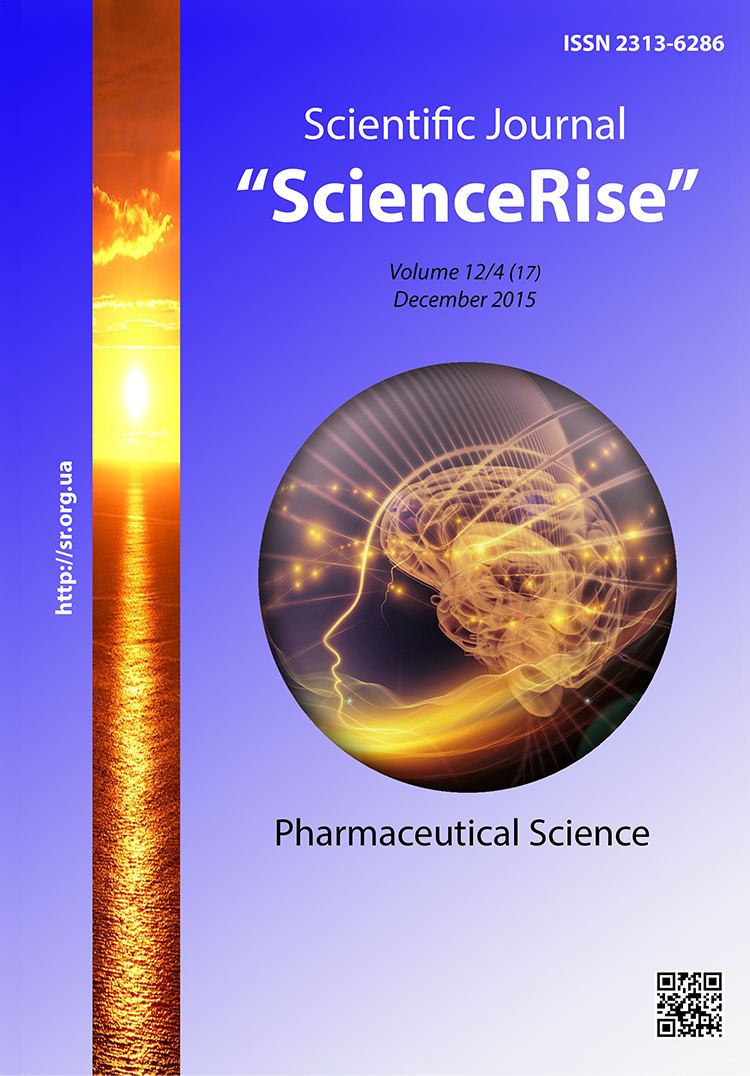Ідентифікація ризиків для якості на етапі фармацевтичної розробки комбінованих очних крапель для терапії глаукоми
DOI:
https://doi.org/10.15587/2313-8416.2015.56944Ключові слова:
лікарський препарат, фармацевтична розробка, QbD, критичний показник якості, оцінка ризиків, ICH Q9Анотація
Мета: Визначення можливих ризиків, що пов'язані з критичними показниками якості комбінованих очних крапель для терапії глаукоми із застосуванням методології загального оцінювання ризиків при плануванні якості лікарського препарату на етапі фармацевтичної розробки.
Методи: В роботі застосовано методику причинно-наслідкового аналізу. Для виявлення потенційних факторів, що оказують найбільш значний вплив на якість лікарського препарату, визначено максимальну кількість факторів, і побудовано діаграму Ішикави - графічне зображення причин та наслідків.
Результати: Проведення аналізу дозволило систематизувати можливі чинники впливу на якість ЛП в такі узагальнені категорії: методи контролю якості, лікарські та допоміжні речовини, первинне пакування, належні виробничі умови та стадії технологічного процесу, для яких визначені найбільш значущі фактори, що є носіями причин ризику і можуть привести до негативних наслідків.
Висновки: Визначені на етапі фармацевтичної розробки потенційні критичні показники якості лікарських і допоміжних речовин, критичні параметри підготовки та проведення процесу, первинного пакування, забезпечують поліпшення розуміння, зниження та прийняття ризиків на подальших етапах життєвого циклу лікарського препаратуПосилання
EMEA/CHMP/167068/2004 Pharmaceutical Development (ICH Q8) (2011). Ministry of Health of Ukraine, 42.
EMA/INS/GMP/79766/2011 Quality Risk Management (ICH Q9) (2011). Ministry of Health of Ukraine, 30.
EMA/INS/GMP/79818/2011 Pharmaceutical Quality System (ICH Q10) (2011). Ministry of Health of Ukraine, 30.
Development and Manufacture of Drag Substances (Chemical Entities and Biotechnological/Biological Entities) Q11 (2012). ICH Harmonised Tripartite Guideline, 26. Available at: http://www.ich.org/fileadmin/Public_Web_Site/ICH_Products/Guidelines/Quality/Q11/Q11_Step_4.pdf
Pharmaceutical CGMPs for the 21st Century: A Risk-Based Approach; A Science and Risk-Based Approach to Product Quality Regulation Incorporating an Integrated Quality Systems Approach, United States Department of Health and Human Services (2002). U.S. Food and Drug Administration. Available at: http://www.fda.gov/Drugs/DevelopmentApprovalProcess/Manufacturing/QuestionsandAnswersonCurrentGoodManufacturingPracticescGMPforDrugs/ucm137175.htm
Guidance for Industry PAT – A Framework for Innovative Pharmaceutical Development, Manufacturing, and Quality Assurance (2004). U.S. Department of Health and Human Services, 19. Available at: http://www.fda.gov/downloads/Drugs/GuidanceComplianceRegulatoryInformation/Guidances/UCM070305.pdf
Mollah, A. H., Longs, M., Bejsmen, G. S. (2014). Risk management in pharmaceutical manufacturing. Moscow: VIALEK Group, 472.
Giher, Z. А. (2010). Practicheskij opyt primenenija sistemi upravlenija riskami v OAO «InterChim» [Practical experience in the application of risk management systems at InterChem SLC]. Pharmacevticheskaja otrasl, 1, 30–33. Available at: http://archive.promoboz.com/n1_18/30-33.pdf
Lebedinets, V. A., Kovalenko, S. N. (2011). Estimation, analysis and management of quality risks at the pharmaceutical enterprise. Management, economy and quality assurance in pharmacy, 6, 10–15.
Shestopal, O. A. (2010). Optimization of quality system components at a pharmaceutical enterprise by application of risk management. Kharkiv, 20.
Kashutsky, S. N., Rusanova, S. V., Dihtyaryov, S. I. (2013). Realization of general estimation of risks for quality and optimization composition of pills tunicate on the stage of pharmaceutical development. Pharmacom, 3, 54–62.
Kashutsky, S. N., Rusanova, S. V., Dihtyaryov et. al (2014). Vyjavlenie riskov dlja kachestva processa proizvodstva lekarstvenogo sredstva v forme tabletok na etapi farmacivticheskoj razrabotki [Identification risks for quality of manufacturing process of a medicament in tablet form at stage of pharmaceutical development]. Vladikavkaz, 106–109.
Kashutsky, S. N., Rusanova, S. V., Dihtyaryov, S. I. et. al (2014). Identificacja riskov dlja kachestva v processi proizvodstva tabletok na etapi farmacivticheskoj razrabotki [Risk identification for quality at manufacturing process of tablets on stage of pharmaceutical development]. Vladikavkaz, 110–112.
Kashutsky, S. N., Rusanova, S. V., Dihtyaryov, S. I. et. al (2015). Some aspects of risk management for the quality of processes of production of the medicine «fenspiride hydrochloride, coated tablets by 0,08 gr» at the stage of pharmaceutical development. Chemical-Pharmaceutical Journal, 11, 49–53.
Andryukova, L. M., Fetisova, Е. G., Yakubchuk, O. M. et. al (2013). Identification of critical quality attribute for eye drops medicinal form. Management, economy and quality assurance in pharmacy, 6, 4–9.
Andryukova, L. M., Yakubchuk, O. M., Fetisova, Е. G. et. al (2014). Common risk evaluation of quality at the stage of pharmaceutical development of eye drops dosage form. Management, economy and quality assurance in pharmacy, 2, 4–7.
Yakubchuk, O. M., Andryukova, L. M., Fetisova, Е. G. et. al (2014). Application of risk assessment in justifying the choice of excipients in the composition of eye drops with antiglaucoma actions. Management, economy and quality assurance in pharmacy, 5, 11–15.
Derzhavna Farmakopeja Ukrai'ny (2004). Kharkiv: OOO Ryreg, 520.
##submission.downloads##
Опубліковано
Номер
Розділ
Ліцензія
Авторське право (c) 2015 Олександр Миколайович Якубчук, Світлана Володимировна Русанова, Олена Геннадіївна Фетісова, Лариса Миколаївна Андрюкова, Володимир Костянтинович Яковенко

Ця робота ліцензується відповідно до Creative Commons Attribution 4.0 International License.
Наше видання використовує положення про авторські права Creative Commons CC BY для журналів відкритого доступу.
Автори, які публікуються у цьому журналі, погоджуються з наступними умовами:
1. Автори залишають за собою право на авторство своєї роботи та передають журналу право першої публікації цієї роботи на умовах ліцензії Creative Commons CC BY, котра дозволяє іншим особам вільно розповсюджувати опубліковану роботу з обов'язковим посиланням на авторів оригінальної роботи та першу публікацію роботи у цьому журналі.
2. Автори мають право укладати самостійні додаткові угоди щодо неексклюзивного розповсюдження роботи у тому вигляді, в якому вона була опублікована цим журналом (наприклад, розміщувати роботу в електронному сховищі установи або публікувати у складі монографії), за умови збереження посилання на першу публікацію роботи у цьому журналі.

